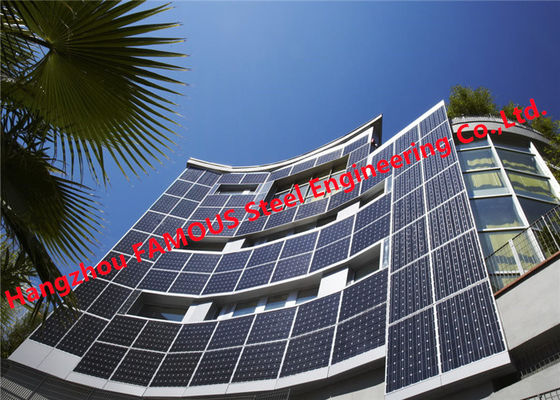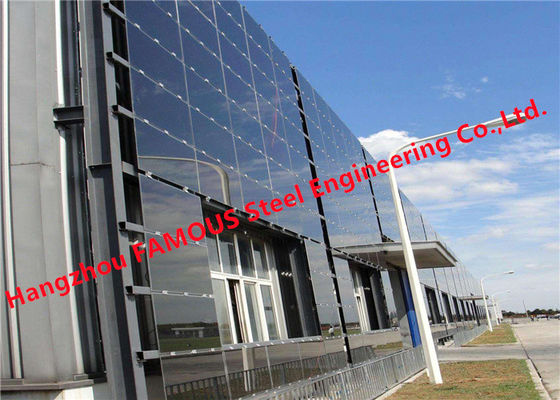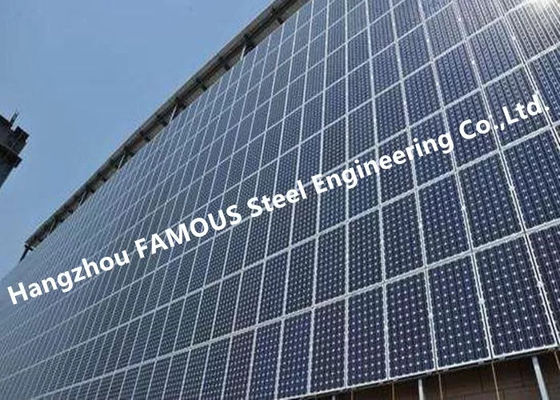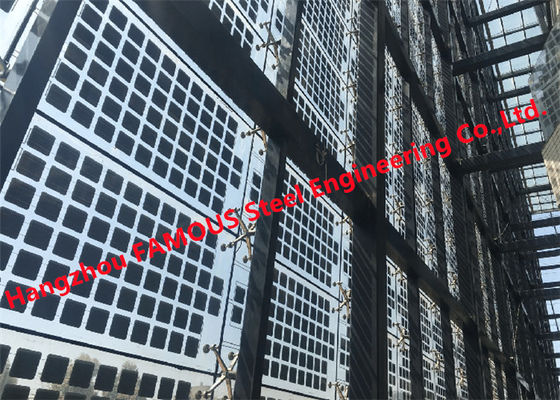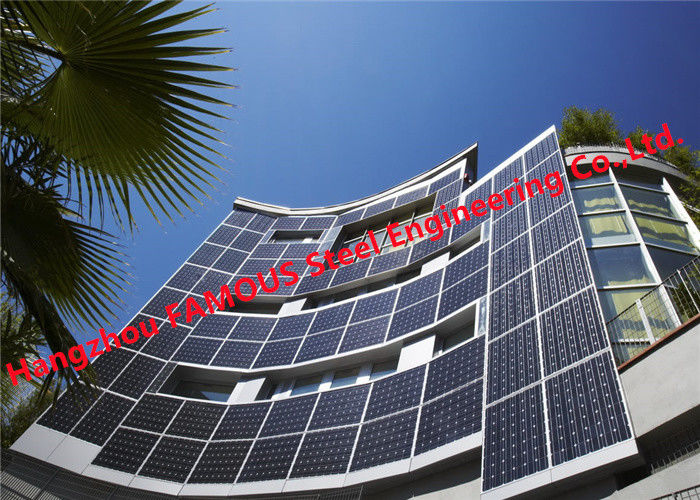Solar BIPV Fireproof Glass Facade Curtain Wall Building Integrated Photovoltaic 5mm 9A 5mm
Product Details:
| Place of Origin: | Zhejiang, China |
| Brand Name: | Fasecbuildings |
| Certification: | EN 1090-2-2018; ISO3834 |
| Model Number: | Hidden Frame |
Payment & Shipping Terms:
| Minimum Order Quantity: | 300 sqm |
|---|---|
| Price: | USD100-550 per sqm |
| Packaging Details: | Seaworthy packing in container or bulk vessel |
| Delivery Time: | Based on client's needs like one month |
| Payment Terms: | L/C,T/T, D/A, D/P, Western Union |
| Supply Ability: | 600,000 sqm per Year |
|
Detail Information |
|||
| Specification: | Solar BIPV | Material: | Steel And Glass |
|---|---|---|---|
| Color: | Customized As Order | Installation: | Very Easy |
| Size: | According To Client's Need | Application: | Commercial Building |
| Highlight: | BIPV glass facade curtain wall,Fireproof glass facade curtain wall,5mm window wall facade |
||
Product Description
Solar BIPV Building-Integrated Photovoltaic Glass Facade Curtain Wall
Photovoltaic glass, also known as "photoelectric glass". A kind of special glass that presses in solar photovoltaic modules, can use solar radiation to generate electricity, and has related current extraction devices and cables. It is composed of glass, solar cells, film, back glass, special metal wires, etc. It is one of the most innovative high-tech glass products for construction. Can withstand wind pressure and large changes in temperature between day and night. It has the advantages of beautiful appearance, controllable light transmission, energy-saving power generation, no fuel, no exhaust gas, no waste heat, no waste residue, no noise pollution, etc. It has a wide range of applications, such as solar smart windows, solar pavilions and photovoltaic glass building roofs, and photovoltaic glass curtain walls. There are two types of crystalline silicon photovoltaic glass and thin-film photovoltaic glass. The former is divided into two types, monocrystalline silicon and polycrystalline silicon, which are often used as curtain wall materials.
Conventional Solar Photovoltaic (PV) Panels can be fixed to the external walls of buildings with brick or block exteriors, using one of the aluminum or stainless steel bracketing systems to connect. Purists would not consider this to be true Building Integrated Photovoltaics as, in such cases, the Solar Photovoltaic (PV) Panels are merely ‘stuck on’ and do not replace an essential material that would otherwise be required in the building process.
Photovoltaic facade curtain wall is a new type of building curtain wall technology, it combines the traditional curtain wall and the photovoltaic effect, and it is a new type of green energy technology, using solar energy to generate electricity. The photovoltaic system is divided into two kinds, which are grid connected system and off grid system. The main features:
1. Photovoltaic facade curtain wall can not only supply the building itself, the power can also be incorporated into the grid, saving energy consumption of the whole buildings.
2. Abundant energy sources. Photovoltaic system is to convert the solar energy into electric energy.
3. Various forms of application: PV modules can be used in various types of curtain wall form (including point type, frame, unit, double layer), roof and sun shading board, etc.;
4. Integration of photovoltaic system and building structure, save the extra space separately placed the battery components and supporting structure also eliminates the need for photovoltaic devices;
5. Photovoltaic components can be applied to the surface of the sun shading effect, to avoid excessive indoor temperature, reducing air conditioning load.
6. Photovoltaic curtain wall is applied to the roof or roof, which can use solar energy more effectively
Specifications:
| Color | Clear |
| Surface treatment | Powder Coating |
| Product name | Solar BIPV Building-Integrated Photovoltaic Glass Facade Curtain Wall |
| Application | Building Exterior |
| Usage | Outdoor Wall Cladding Decoration |
| Thickness | 5+9A+5mm |
| Function | Fireproof |
| Glass | Tempered Glass |
| Certificates | CE/SONCAP/ISO9000 |
| Size | customized |
| Product Keywords | Engineering Photovoltaic Curtain Wall |
Solar Photovoltaic (PV) Facades – Facade Curtain Wall Systems
There are two main building facade systems that readily lend themselves to the incorporation of Solar PV technology: Rain screen Cladding (Ventilated Facade) type and Curtain Walling type.
Increasingly, Solar Photovoltaic Panels are being incorporated into the construction of new buildings as a principle source, or an ancillary source of electrical power. Solar PV Panels can also be incorporated into existing buildings where wall cladding materials are being substituted.
Solar PV Facades Curtain Wall - Rain screen Cladding
(Ventilated Facade Glass Curtain Wall)
Rain screen cladding systems were primarily developed in the Europe for the refurbishment of high-rise concrete framed buildings, particularly apartment buildings and office blocks etc. Rain screen cladding system is ideally suited to new buildings but is also widely used for the renovation of older high-rise buildings with poorly performing building envelopes. Rain screen cladding construction allows the refurbishment process to be carried out while the building is still occupied.
Solar PV Facades – Fixing Rain screen Cladding Type
Rain screen cladding forms the outer skin of a building. It is a building facade system that consists of a stainless steel sub-frame infilled with cladding panels, typically of bricks, brick tiles or ceramic tiles. The stainless steel cladding rails and fixing brackets are bolted onto the internal wall ready to receive the rain screen outer layer. This cladding system is designed so that the cladding panels stand-off from the internal insulated wall in order to create a wide ventilated cavity between the two. The cavity stops driving rain, that may penetrate the rain screen cladding material, from adversely affecting the insulated inner wall.
Solar PV Facades - Solar Cell Electric Systems (PV system)
In rain screen cladding systems, the cladding panels are usually opaque. In such circumstances designers often opt to install conventional Solar PV Panels as they are also opaque and are generally the cheapest method of producing solar electricity.
In projects where the design brief calls for transparent or semi-transparent glass panels, toughened double or triple glazed panes with thin film Solar PV Cells can be incorporated in the rain screen grid.
Solar PV Facades – Rain screen Cladding
The cavity wall format of rain screen cladding can significantly improve the efficiency of the integrated crystalline silicon Solar PV Panels. The ventilation zone behind the Solar PV Panels allows thermal currents to circulate between the back of the module and the inner wall of the building, preventing any accumulation of heat and maximizing the performance of the Solar PV, even when outside temperatures are high.
Advantages:
1. Energy saving: As the photoelectric curtain wall is used as the building's outer protection system and directly absorbs solar energy, it avoids excessively high wall and roof temperature, which can effectively reduce the temperature rise of the wall and roof, reduce the air conditioning load, and reduce air conditioning energy consumption.
2. Protect the environment: The photovoltaic curtain wall generates electricity through solar energy. It does not need fuel, produce no exhaust gas, no waste heat, no waste residue, and no noise pollution.
3. New and practical: to ease the power demand during the daytime peak period of power consumption, and solve the power supply situation in power-stressed areas and areas with no electricity and less electricity. It can generate electricity and use it in situ, reducing the cost and energy consumption of the current transportation process; at the same time, it avoids the additional occupation of valuable building space for placing the photovoltaic array board, and it is integrated with the building structure to eliminate the need for a separate support structure for photovoltaic equipment , It is also between the expensive exterior decoration materials, reducing the overall cost of the building.
4. Special effects: The photoelectric curtain wall itself has a strong decorative effect. Various photovoltaic modules are used in the middle of the glass, and the colors are diverse, making the building rich in artistic expression. At the same time, the back of the photoelectric template can be lined with the designer's favorite color to adapt to different architectural styles.
![]()



